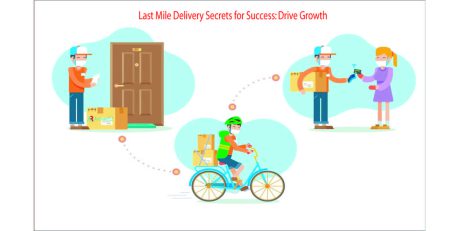Same-Day Delivery Challenges: A Comprehensive Guide to Ensuring Unrivalled Reliability
Arrived EZ2024-01-11T09:17:12+00:00In today’s fast-paced world, the demand for same-day delivery services has skyrocketed. Consumers crave instant gratification, and businesses are stepping up to the challenge by offering same-day delivery options. However, ensuring the reliability of these services is no small feat. In this comprehensive guide, we will delve into the challenges associated with same-day delivery and provide valuable insights on how businesses can overcome them to deliver an unparalleled customer experience.
Table of Contents:
The Rise of Same-Day Delivery: A Paradigm Shift
Brief overview of the evolution of delivery services.
Same-day delivery services have undergone a remarkable evolution, transforming the way goods and services are transported and received. Here’s a brief overview of the key milestones in the evolution of same-day delivery:
Traditional Retail and Local Delivery:
Before the digital age, local delivery was often handled by individual retailers or small businesses in close proximity to the customer.
Customers relied on brick-and-mortar stores for their immediate needs.
Early E-Commerce and Expedited Shipping:
The rise of e-commerce in the late 20th century led to the introduction of expedited shipping options, providing faster delivery for online orders.
Companies like Amazon began offering faster shipping services, reducing delivery times to two days or even overnight.
Same-Day Delivery Trials:
In the mid-2010s, major e-commerce players started experimenting with same-day delivery as a competitive advantage.
Amazon Prime Now, launched in 2014, allowed members to receive select items within the same day.
Expansion of On-Demand Delivery Startups:
The emergence of on-demand delivery startups like Postmates, Instacart, and Door Dash in the mid-2010s introduced the concept of delivering various goods, including groceries and restaurant meals, on the same day.
Retailers Adopting Same-Day Delivery:
Brick-and-mortar retailers began offering same-day delivery services to compete with e-commerce giants.
Companies like Walmart and Target introduced same-day delivery options to cater to the changing consumer demands.
Gig Economy and Crowd sourced Delivery:
The gig economy played a crucial role in the evolution of same-day delivery, with independent contractors and freelancers handling last-mile deliveries.
Platforms like Uber and Lyft ventured into the delivery space with services like UberEats and UberRUSH.
Technology and Logistics Innovations:
Advancements in technology, including route optimization algorithms and real-time tracking, enhanced the efficiency of same-day delivery services.
Companies invested in logistics infrastructure and partnerships to streamline their delivery operations.
Integration of Drones and Autonomous Vehicles:
Some companies explored the use of drones and autonomous vehicles for same-day deliveries to further reduce delivery times and costs.
Regulatory challenges and technology limitations slowed widespread adoption but signalled potential future developments.
Pandemic Acceleration:
The COVID-19 pandemic accelerated the demand for same-day delivery services as more consumers turned to online shopping.
Retailers and delivery platforms adapted quickly to meet the surge in demand for convenient and rapid delivery options.
Ongoing Innovations and Market Competition:
Competition in the same-day delivery space remains fierce, with companies continually innovating to provide faster and more reliable services.
Subscription models, loyalty programs, and partnerships with local businesses contribute to the evolution of same-day delivery offerings.
The evolution of same-day delivery reflects a dynamic interplay between consumer expectations, technological advancements, and market competition, shaping a landscape where convenience and speed are paramount.
Top of Form
Bottom of Form
The impact of same-day delivery on consumer expectations.
Same-day delivery has significantly impacted consumer expectations and behaviours, revolutionizing the way people shop and receive goods. Here are several key aspects of the impact of same-day delivery on consumer expectations:
Instant Gratification:
Same-day delivery caters to the consumer’s desire for instant gratification. It has set a new standard for quick and efficient service, fostering an expectation that products should be available immediately.
Increased Convenience:
Consumers now expect a higher level of convenience in their shopping experience. Same-day delivery eliminates the need for planning ahead, allowing consumers to make spontaneous purchases without the wait.
Competitive Advantage for Retailers:
Retailers offering same-day delivery gain a competitive edge. As a result, consumers come to expect this service as a standard offering, and those businesses not providing it may be perceived as less competitive.
Elevated Customer Experience:
Same-day delivery contributes to an enhanced overall customer experience. Meeting or exceeding consumer expectations in terms of speed and convenience positively impacts brand loyalty and customer satisfaction.
Flexibility and Control:
Consumers appreciate the flexibility and control that same-day delivery provides. They can schedule deliveries at their convenience, reducing the uncertainty associated with traditional delivery timelines.
Changing Shopping Habits:
Same-day delivery has influenced a shift in consumer shopping habits. It encourages more online purchases, especially for urgent or last-minute needs, as consumers become accustomed to the idea of quick turnaround times.
Expectation of Transparency:
Consumers now expect transparent and real-time tracking information for their orders. The ability to monitor the delivery process in real-time has become an integral part of the overall customer experience.
Rising Demand for Diverse Product Categories:
The success of same-day delivery in certain product categories, such as groceries and electronics, has expanded consumer expectations. People now seek this service for a broader range of products, including items that were traditionally not associated with rapid delivery.
Challenges in Implementation:
Consumers also face challenges when the same-day delivery promise is not met. Delays or disruptions can lead to dissatisfaction, emphasizing the importance of reliable logistics and communication.
Impact on Loyalty Programs:
Companies often leverage same-day delivery as part of loyalty programs to attract and retain customers. As a result, consumers may come to expect such perks as a standard feature of loyalty programs across industries.
In summary, the advent of same-day delivery has reshaped consumer expectations by emphasizing speed, convenience, and flexibility. Businesses that effectively integrate and meet these expectations are likely to thrive in the evolving landscape of consumer preferences.

Challenges in Same-Day Delivery: Roadblocks to Reliability
Logistical Hurdles
Implementing same-day delivery can be a competitive advantage for businesses, but it comes with its own set of logistical hurdles. Overcoming these challenges is crucial to providing a seamless and reliable service. Here are some common logistical hurdles associated with same-day delivery:
Order Processing Time:
Challenge: Efficiently processing orders in real-time can be challenging, especially during peak hours.
Solution: Implement automated order processing systems to streamline the workflow and reduce manual errors.
Inventory Management:
Challenge: Accurate and real-time inventory tracking is essential to prevent overselling and stockouts.
Solution: Use advanced inventory management systems that integrate with your e-commerce platform for instant updates.
Warehouse Efficiency:
Challenge: Ensuring that items are picked, packed, and dispatched promptly requires efficient warehouse operations.
Solution: Optimize warehouse layout, invest in automation, and use smart picking technologies to improve efficiency.
Last-Mile Delivery:
Challenge: Delivering packages to customers’ doorsteps within a short timeframe can be complicated, especially in urban areas.
Solution: Utilize local distribution centres, partner with local courier services, and explore innovative delivery options such as drones or crowdsourced delivery.
Traffic and Weather Conditions:
Challenge: External factors like traffic congestion and adverse weather conditions can delay deliveries.
Solution: Implement route optimization software and leverage real-time traffic updates to plan efficient delivery routes. Additionally, have contingency plans for weather-related disruptions.
Customer Communication:
Challenge: Keeping customers informed about the status of their delivery in real-time is crucial for a positive experience.
Solution: Implement a robust tracking and notification system, providing customers with timely updates on their delivery status via SMS, email, or a dedicated app.
Delivery Time Windows:
Challenge: Offering specific delivery time windows can be challenging, especially with variable order volumes.
Solution: Implement dynamic delivery time windows based on factors like location, order volume, and historical data. Communicate realistic time frames to customers.
Returns and Exchanges:
Challenge: Managing returns and exchanges within the same-day delivery framework requires efficient processes.
Solution: Establish clear and user-friendly return policies, and provide customers with easy-to-follow instructions for returns. Streamline the reverse logistics process.
Regulatory Compliance:
Challenge: Adhering to local regulations and compliance standards for delivery services can be complex.
Solution: Stay informed about local regulations, obtain necessary permits, and ensure that your delivery operations comply with relevant laws.
Cost Management:
Challenge: Offering same-day delivery can be costly due to expedited shipping, additional manpower, and technology investments.
Solution: Optimize delivery routes, negotiate favorable rates with logistics partners, and consider variable pricing based on delivery times.
By addressing these logistical challenges, businesses can enhance the efficiency and reliability of their same-day delivery services, ultimately improving customer satisfaction and loyalty.
Top of Form
Traffic congestion and route optimization.
Utilizing route optimization and addressing traffic congestion is crucial in the context of same-day delivery services. Efficient route planning not only helps in meeting tight delivery deadlines but also contributes to cost reduction and customer satisfaction. Here’s how you can address traffic congestion and optimize routes in the context of same-day delivery:
Real-Time Traffic Monitoring:
Integrate a real-time traffic monitoring system that provides up-to-date information on road conditions, accidents, and congestion.
Use GPS and mapping APIs to continuously analyze traffic patterns and dynamically adjust delivery routes.
Predictive Analytics:
Implement predictive analytics algorithms to forecast potential traffic congestion based on historical data, special events, and time of day.
Adjust delivery schedules or routes proactively to avoid anticipated congestion.
Dynamic Route Optimization:
Utilize route optimization algorithms that consider real-time traffic data, delivery time windows, and vehicle capacities.
Automatically re-route delivery vehicles to avoid traffic jams and optimize delivery schedules dynamically.
Geofencing Technology:
Implement geofencing to define specific delivery zones and optimize routes within those boundaries.
Trigger alerts or rerouting options when a delivery vehicle enters a congested area.
Machine Learning for Pattern Recognition:
Train machine learning models to recognize patterns in delivery data, such as peak traffic hours or areas with frequent congestion.
Use these models to optimize routes and delivery schedules based on historical and real-time data.
Customer Communication:
Implement a communication system that keeps customers informed about the status of their deliveries, including any delays caused by traffic congestion.
Provide real-time tracking information to manage customer expectations effectively.
Alternative Delivery Methods:
Consider alternative delivery methods such as drones or autonomous vehicles for certain types of deliveries to bypass road congestion.
Evaluate the feasibility and regulatory requirements for implementing such technologies.
Collaboration with Local Authorities:
Work with local authorities to access traffic management data and coordinate delivery schedules during peak hours.
Collaborate on initiatives to improve traffic flow and reduce congestion in key delivery areas.
Data Integration and Visibility:
Integrate data from various sources, including traffic APIs, weather conditions, and historical delivery data, to make more informed decisions.
Provide visibility to all stakeholders, including drivers and dispatchers, to enhance coordination.
Continuous Optimization and Learning:
Regularly analyze the performance of delivery routes and use the insights to refine optimization algorithms.
Stay updated on technological advancements and continuously improve the system for better efficiency.
Implementing these strategies can help mitigate the challenges of traffic congestion and enhance the overall efficiency of same-day delivery services.
Top of Form
Bottom of Form
Efficient warehouse management.
Efficient warehouse management is crucial for businesses to streamline operations, reduce costs, and enhance overall productivity. Here are some key strategies and best practices for efficient warehouse management:
Optimized Layout and Organization:
Design the warehouse layout for optimal flow, minimizing the distance travelled by items.
Group products based on demand and frequency of retrieval.
Use vertical space efficiently with tall shelves and mezzanines.
Inventory Management System:
Implement a robust inventory management system to track stock levels, reorder points, and order processing.
Use barcode or RFID systems for accurate and speedy item identification.
Regularly conduct cycle counts and audits to maintain accurate inventory records.
Automation and Technology:
Invest in warehouse management systems (WMS) for real-time tracking and visibility into inventory.
Utilize automation technologies such as conveyor systems, robotics, and automated guided vehicles (AGVs) to streamline processes.
Implement picking technologies like pick-to-light and voice picking to improve order accuracy and speed.
Demand Forecasting:
Use historical data and analytics to forecast demand accurately.
Adjust inventory levels based on seasonal trends, promotions, and market changes.
Collaborate with suppliers to ensure a steady supply chain.
Supplier Collaboration:
Establish strong relationships with suppliers to improve lead times and order fulfillment.
Implement just-in-time inventory practices to minimize excess stock.
Use vendor-managed inventory (VMI) systems for seamless collaboration.
Cross-Docking:
Implement cross-docking strategies to reduce storage times and minimize handling.
Directly transfer products from inbound to outbound transportation without storage.
Employee Training:
Provide comprehensive training to warehouse staff for efficient handling of equipment and systems.
Cross-train employees to handle multiple tasks, reducing dependency on specific individuals.
Quality Control:
Implement rigorous quality control processes to minimize errors and returns.
Conduct regular inspections to identify and address issues promptly.
Real-time Visibility:
Use technology to provide real-time visibility into warehouse operations.
Monitor key performance indicators (KPIs) such as order fulfillment rates, cycle times, and inventory turnover.
Continuous Improvement:
Regularly assess and optimize warehouse processes for efficiency.
Encourage a culture of continuous improvement, where employees actively contribute ideas for enhancement.
Energy Efficiency:
Implement energy-efficient practices, such as LED lighting and energy-efficient equipment, to reduce operational costs.
By integrating these strategies, businesses can enhance the overall efficiency of warehouse management, leading to improved customer satisfaction and increased competitiveness in the market.
Top of Form
Inventory tracking and fulfilment challenges.
Inventory tracking and fulfilment are critical components of a successful business, and they come with their own set of challenges. Here are some common challenges associated with inventory tracking and fulfillment:
Inaccurate Inventory Data:
Cause: Manual data entry errors, theft, damage, or other discrepancies can lead to inaccurate inventory levels.
Solution: Implement barcode or RFID systems, and regularly conduct audits to reconcile physical inventory with recorded levels.
Order Processing Delays:
Cause: Inefficient order processing systems, lack of automation, or poor coordination between departments.
Solution: Implement an integrated order management system, use automation tools, and streamline communication between sales, warehouse, and fulfilment teams.
Stockouts and Overstocks:
Cause: Inadequate demand forecasting, inaccurate sales data, or delayed shipments from suppliers can result in stockouts or overstocks.
Solution: Use advanced forecasting tools, maintain safety stock levels, and establish strong relationships with reliable suppliers.
Multi-channel Selling Challenges:
Cause: Managing inventory across various sales channels (online, offline, wholesale) can lead to difficulties in maintaining accurate stock levels.
Solution: Implement a centralized inventory management system that syncs across all channels, ensuring real-time updates and accurate information.
Supplier Reliability:
Cause: Dependence on a single supplier or unreliable suppliers can lead to delays and disruptions in the supply chain.
Solution: Diversify your supplier base, maintain good communication with suppliers, and have contingency plans in place for potential disruptions.
Lack of Visibility:
Cause: Limited visibility into the entire supply chain can make it challenging to identify bottlenecks or areas for improvement.
Solution: Use technology such as RFID, IoT devices, and analytics tools to gain real-time visibility into the entire supply chain.
Returns and Reverse Logistics:
Cause: Inefficient returns management and lack of a structured reverse logistics process.
Solution: Develop a clear returns policy, automate return processes, and integrate reverse logistics into your overall supply chain strategy.
Technology Integration Issues:
Cause: Outdated or incompatible systems that do not communicate effectively can hinder smooth inventory and fulfillment processes.
Solution: Invest in integrated software solutions that can connect various aspects of your business, from sales to inventory to fulfillment.
High Shipping Costs:
Cause: Inefficient shipping practices, lack of negotiated shipping rates, or inaccurate address data.
Solution: Optimize shipping processes, negotiate favorable shipping rates, and implement address verification systems.
Regulatory Compliance:
Cause: Failure to comply with regulations related to inventory storage, labeling, or transportation.
Solution: Stay informed about relevant regulations, implement compliance processes, and conduct regular audits to ensure adherence.
Successfully addressing these challenges requires a combination of effective technology, streamlined processes, and a proactive approach to managing the complexities of inventory tracking and fulfilment.
Technological Barriers
Integration of advanced tracking systems.
The integration of advanced tracking systems involves incorporating sophisticated technologies and software to monitor and manage various processes, assets, or activities. These systems can be applied in diverse fields such as logistics, transportation, healthcare, manufacturing, and more. Here are some general steps and considerations for integrating advanced tracking systems:
Define Objectives and Requirements:
Clearly define the goals and objectives of implementing advanced tracking systems. Identify the specific processes, assets, or activities you want to track.
List the key requirements such as real-time tracking, data accuracy, scalability, and integration with existing systems.

Choose the Right Technology:
Select the appropriate tracking technologies based on your requirements. This could include GPS, RFID, sensors, barcode systems, or a combination of these technologies.
Consider factors such as accuracy, range, cost, and power consumption when choosing the tracking technology.
Select a Tracking System Provider:
Research and choose a reliable tracking system provider that offers the technology and solutions that align with your needs.
Evaluate the provider’s track record, customer reviews, and their ability to provide ongoing support and updates.
Integrate with Existing Systems:
Ensure that the tracking system can seamlessly integrate with your existing software and systems, such as ERP (Enterprise Resource Planning), CRM (Customer Relationship Management), or other relevant applications.
APIs (Application Programming Interfaces) are often used for smooth integration between different systems.
Customization and Configuration:
Customize the tracking system to meet your specific requirements. This may involve configuring parameters, setting up alerts, and defining reporting metrics.
Consider the user interface and reporting tools to ensure that the information provided is actionable and user-friendly.
Data Security and Privacy:
Implement robust security measures to protect the tracking data from unauthorized access or manipulation.
Comply with data privacy regulations and establish protocols for handling sensitive information.
Training and Change Management:
Provide training to users who will interact with the tracking system. Ensure that they understand how to use the system effectively and interpret the data.
Implement change management strategies to facilitate a smooth transition to the new tracking system.
Test and Validate:
Conduct thorough testing of the integrated tracking system before deploying it on a larger scale. This helps identify and address any issues or bugs.
Validate the system’s performance against the defined objectives and requirements.
Scale and Monitor:
Once validated, scale the tracking system to cover the desired scope of operations.
Implement ongoing monitoring and maintenance to address any issues, update software, and ensure continued efficiency.
Continuous Improvement:
Gather feedback from users and stakeholders to identify areas for improvement.
Stay informed about advancements in tracking technology and update the system accordingly to leverage new features and capabilities.
By following these steps, organizations can successfully integrate advanced tracking systems to enhance efficiency, visibility, and control over their processes and assetsTop of Form
By addressing the challenges head-on and implementing strategic solutions, businesses can not only meet the growing demand for same-day delivery but also ensure unparalleled reliability, earning the trust and loyalty of their customers in the competitive landscape of e-commerce. Stay ahead of the curve, embrace technology, and deliver excellence with every order!










Leave a Reply